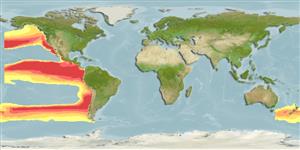Environment: milieu / climate zone / depth range / distribution range
Écologie
marin bathypélagique; profondeur 64 - 1000 m (Ref. 96339). Deep-water
Eastern Central Pacific: Point Conception, California, USA to Panama, and Guadalupe and Galapagos Islands.
Taille / Poids / Âge
Maturity: Lm ? range ? - ? cm
Max length : 90.0 cm TL mâle / non sexé; (Ref. 28023)
Description synthétique
Clés d'identification | Morphologie | Morphométrie
Color uniformly brown.
Feeds on small deep-sea crustaceans (Ref. 28023). Caught well offshore in pelagic waters to depths of several hundred meters (Ref. 28023).
Life cycle and mating behavior
Maturities | Reproduction | Spawnings | Egg(s) | Fecundities | Larves
Grove, J.S. and R.J. Lavenberg, 1997. The fishes of the Galápagos Islands. Stanford University Press, Stanford, 863 p. (Ref. 28023)
Statut dans la liste rouge de l'IUCN (Ref. 130435)
Menace pour l'homme
Harmless
Utilisations par l'homme
Outils
Articles particuliers
Télécharger en XML
Sources Internet
Estimates based on models
Preferred temperature (Ref.
123201): 7.1 - 13.4, mean 9.6 °C (based on 59 cells).
Phylogenetic diversity index (Ref.
82804): PD
50 = 0.5156 [Uniqueness, from 0.5 = low to 2.0 = high].
Bayesian length-weight: a=0.00089 (0.00036 - 0.00223), b=2.98 (2.77 - 3.19), in cm total length, based on LWR estimates for this (Sub)family-body shape (Ref.
93245).
Niveau trophique (Ref.
69278): 3.1 ±0.30 se; based on food items.
Résilience (Ref.
120179): Milieu, temps minimum de doublement de population : 1,4 à 4,4 années (tm=4).
Fishing Vulnerability (Ref.
59153): High vulnerability (56 of 100).
